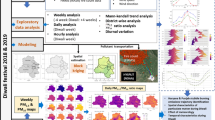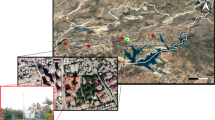Abstract
The article develops a new method of spatiotemporal modelling of possible locations of ragweed areas and estimation of pollen emission intensity of these areas. The method uses spline approximation with automatic computations of typical pollen production models in the R language. It applies a number of approaches eliminating the uncertainty of various parameters that should be taken into consideration for this modelling. The authors have consolidated some experimental data on the amount of Ambrosia pollen in the air depending on environmental conditions, and found some new possible ragweed pollen sources on the territory of the city of Vinnytsia and the adjacent villages. The study used spline approximation of the first (lines) and second (parabolas) orders were applied. Data of bi-hourly pollen concentrations were obtained at the pollen monitoring site of National Pirogov Memorial Medical University (Vinnytsia). To perform the approximation, wind speed, wind direction and relative humidity were taken into the consideration. The authors used the polar coordinate system to formalize the problem. PRA Finder computer program was developed, which has been successfully tested on real data and for which a certificate of copyright registration has been obtained in Ukraine. As a result of the method application, the known areas were corroborated and new possible plots were revealed. The comparison of the forecasted areas for 2014 with the actual ones showed a close match. However, it should be taken into consideration that the proposed method is viable only when applied under the condition that the wind velocity does not exceed 4 m/sec and the relative humidity is between 20 and 90%.





Similar content being viewed by others
Availability of data and material
Authors declare that all the data used for this study were either the intellectual property of the authors or obtained from the available sources.
References
Allergenic Pollen. A Review of the Production, Release, Distribution and Health Impacts. In: Sofiev M., Bergmann K.-C. (2013). Springer Science Business Media Dordrecht 2013. https://doi.org/10.1007/978-94-007-4881-1.
de Weger, L. A., Pashley, C. H., Šikoparija, B., Skjøth, C. A., Kasprzyk, I., Grewling, Ł, Thibaudon, M., Magyar, D., & Smith, M. (2016). The long distance transport of airborne Ambrosia pollen to the UK and the Netherlands from Central and south Europe. International Journal of Biometeorology, 60, 1829–1839. https://doi.org/10.1007/s00484-016-1170-7.
Duhl, T., Zhang, R., Guenther, A. B., et al. (2013). The Simulator of the Timing and Magnitude of Pollen Season (STaMPS) model: A pollen production model for regional emission and transport modelling, 2013. Geoscientific Model Development Discussions, 6(6), 2325–2368. https://doi.org/10.5194/gmdd-6-2325-2013.
Galán, C., Smith, M., Thibaudon, M., Frenguelli, G., Oteros, J., Gehrig, R., Berger, U., Clot, B., & Brandao, R. (2014). Pollen monitoring: Minimum requirements and reproducibility of analysis. Aerobiologia, 30, 385–395. https://doi.org/10.1007/s10453-014-9335-5.
Halbritter, H., et al. (2018). Pollen morphology and ultrastructure. In H. Halbritter, et al. (Eds.), Illustrated pollen terminology.Cham: Springer. https://doi.org/10.1007/978-3-319-71365-6_3.
Hamaoui-Laguel, L., Vautard, R., Liu, L., Solmon, F., Viovy, N., & Epstein, M. M. (2015). Effects of climate change and seed dispersal on airborne ragweed pollen loads in Europe. Nature Climate Change, 5, 766–771.
Hirst, J. M. (1952). An automatic volumetric spore trap. The Annals of Applied Biology, 39, 257–265.
Hui, L., Mingli, Zh., Pengpeng, W., & Miao, M. (2018). Study on pollination biology of the invasive plant Xanthium italicum Moretti. Acta Ecologica Sinica. https://doi.org/10.5846/stxb201701180158.
Kawashima, S., Kobayashi, S., Tanaka K. (2016). Modelling of Pollen Emission Process for Dispersal Simulation of Birch Pollen. In: AirPollution Modelling and its Application XXIV.https://doi.org/10.1007/978-3-319-24478-5_54.
Liu, L., Solmon, F., Vautard, R., et al. (2016). Ragweed pollen production and dispersion modelling within a regional climate system, calibration and application over Europe. Biogeosciences, 13(9), 2769–2786. https://doi.org/10.5194/bg-13-2769-2016.
Liu, L., Solmon, F., Vautard, R., Hamaoui-Lague, L., Torma, C. Z., & Giorgi, F. (2015). Ragweed pollen production and dispersion modelling within a regional climate system, calibration and application over Europe. Biogeosciences Discussions, 12(21), 17595–17641. https://doi.org/10.5194/bgd-12-17595-2015.
Lugonja, P., Brdar, S., Simović, I., Mimić, G., Palamarchuk, Y., Sofiev, M., & Šikoparija, B. (2019). Integration of in situ and satellite data for top-down mapping of Ambrosia infection level. Remote Sensing of Environment, 235, 111455. https://doi.org/10.1016/j.rse.2019.111455.
Makra, L., & Juhász, M. (2004). Meteorological variables connected with airborne ragweed pollen in Southern Hungary. International Journal of Biometeorology, 49(1), 37–47. https://doi.org/10.1007/s00484-004-0208-4.
Martin, M. D., Chamecki, M., & Brush, G. S. (2010). Anthesis synchronization and floral morphology determine diurnal patterns of ragweed pollen dispersal. Agricultural and Forest Meteorology, 150, 1307–1317.
Matyasovszky, I., Makra, L., Tusnády, G., Csépe, Z., Nyúl, L. G., & Chapman, D. S. (2018). Biogeographical drivers of ragweed pollen concentrations in Europe. Theoretical and Applied Climatology, 133(1–2), 277–295.
Maya-Manzano, J. M., Smith, M., Markey, E., Clancy, J. H., Sodeau, J., & O´Connor, D. J. (2020). Recent developments in monitoring and modelling airborne pollen a review. Grana. https://doi.org/10.1080/00173134.2020.1769176.
Mokin, V. B. (2007). Development of the geoinformation system of the state ecological monitoring. In A. Morris & S. Kokhan (Eds.), Geographic uncertainty in environmental security.NATO Science for Peace and Security Series C Environmental Security. https://doi.org/10.1007/978-1-4020-6438-8_9.
Montagnani, C., Gentili, R., Smith, M., Guarino, M. F., & Citterio, S. (2017). The worldwide spread, success, and impact of Ragweed (Ambrosia spp.). Critical Reviews in Plant Sciences. https://doi.org/10.1080/07352689.2017.1360112.
Paschalidou, A. K., Psistaki, K., Charalampopoulos, A., Vokou, D., Kassomenos, P., & Damialis, A. (2020). Identifying patterns of airborne pollen distribution using a synoptic climatology approach. Science of the Total Environment, 714, 136625. https://doi.org/10.1016/j.scitotenv.2020.136625.
Perez, C. F., Castã Neda, M. E., Gassmann, M. I., & Bianchi, M. M. (2009). A statistical study of Weinmannia pollen trajectories across the Andes, October 2009. Advances in Geosciences, 22, 79–84.
Potier, A., Khvorostyanov, D., Menut, L., et al. (2013). Modelling birch pollen emission and transport with the chemistry-transport model CHIMERE, April 2013.
Prank, M., Chapman, D. S., Bullock, J. M., Belmonte, J., Berger, U., Dahl, A., et al. (2013). An operational model for forecasting ragweed pollen release and dispersion in Europe. Agricultural and Forest Meteorology, 182–183, 43–53.
Report about the condition of the natural environment of the Vinnytsia region in 2016. (2017). (Дoпoвiдь пpo cтaн пpиpoднoгo cepeдoвищa y Biнницькiй oблacтi, 2016 piк). Resource document. Ministry of Ecology and Natural Resources of Ukraine. https://menr.gov.ua/files/docs/Reg.report/%D0%92%D1%96%D0%BD%D0%BD%D0%B8%D1%86%D1%8C%D0%BA%D0%B0_%D0%94%D0%BE%D0%BF_2016.pdf. Accessed 04 April 2021 (in Ukrainian).
Rodinkova, V., Palamarchuk, O., Toziuk, O., & Yermishev, O. (2018). Modelling hay fever risk factors caused by pollen from Ambrosia spp. using pollen load mapping in Ukraine. Act Agrobot, 71(3), 1742.
Rodinkova, V., Yuriev, S., Chopyak, V., Dityatkovaskaya, E., Gashinova, E., Bezdetko, T., et al. (2019). Molecular data of pollen sensitization corresponds with pollen spectrum of Ukraine. Allergy, 74(Suppl. 106), 41. https://doi.org/10.1111/all.13957.
Sikoparija, B., Skjøth, C. A., Celenk, S., et al. (2017). Spatial and temporal variations in airborne Ambrosia pollen in Europe. Aerobiologia, 33, 181–189. https://doi.org/10.1007/s10453-016-9463-1.
Skjøth, C. A., Sun, Y., Karrer, G., Sikoparija, B., Smith, M., Schaffner, U., & Müller-Schärer, H. (2019). Predicting abundances of invasive ragweed across Europe using a “top-down” approach. Science of the Total Environment, 686(2019), 212–222.
Stefanic, E., Kovacevic, V., & Lazanin, Z. (2005). Airborne ragweed pollen concentration in northeastern Croatia and its relationship with meteorological parameters. Annals of Agricultural and Environmental Medicine, 12, 75–79.
Stepalska, D. (2020). High Ambrosia pollen concentrations in Poland respecting the long distance transport (LDT) б 2020, https://doi.org/10.1016/j.scitotenv.2020.139615 International Journal of Biometeorology 60(12) COST Action Review.
Stępalska, D., Myszkowska, D., Piotrowicz, K., Kluska, K., Chłopek, K., Grewling, L., Lafférsová, J., Majkowska-Wojciechowska, B., Malkiewicz, M., Piotrowska-Weryszko, K., Puck, M., Rodinkova, V., Rybníčekm, O., Ščevkován, J., & Voloshchuko, K. (2020). High Ambrosia pollen concentrations in Poland respecting the long distance transport (LDT). Science of the Total Environment, 736, 139615. https://doi.org/10.1016/j.scitotenv.2020.139615Get.
Tellería, M. C., & Katinas, L. (2005). The unusual occurrence of tricolpate pollen within Mutisieae (Asteraceae). Grana, 44(2), 91–97. https://doi.org/10.1080/00173130510010495.
Zink, K., Vogel, H., Vogel, B., Magyar, D., & Kottmeier, C. (2012). Modelling the dispersion of Ambrosia pollen with the model system COSMO-ART. International Journal of Biometeorology, 56, 669–680.
Acknowledgements
The authors would like to thank Aliona Dratsion for editing this article. The authors would like to thank Aliona Dratsion and Tetiana Neprytska, PhD, for editing this article.
Funding
The study was supported by the statutory funds of the Scientific Research Center of the National Pirogov Memorial Medical University, Vinnytsya and by the Department of System analysis and information technologies of the Vinnytsia National Technical University.
Author information
Authors and Affiliations
Contributions
V. Rodinkova—pollen count data, manuscript concept, editing, reviewing; V. Mokin—spline interpolation application, methodology, its step-by-step explanation; T. Vuzh—writing the first draft of the manuscript, editing, reviewing, investigation and mapping of areas, infested by ragweed; M. Dratovanyj—R language programming, performance of simulation.
Corresponding author
Ethics declarations
Conflict of interest
Authors declare neither conflict of interest nor competing interests.
Rights and permissions
About this article
Cite this article
Rodinkova, V., Mokin, V., Vuzh, T. et al. Spline interpolation as a way of mapping pollen emission sources. Aerobiologia 37, 695–706 (2021). https://doi.org/10.1007/s10453-021-09707-6
Received:
Accepted:
Published:
Issue Date:
DOI: https://doi.org/10.1007/s10453-021-09707-6




